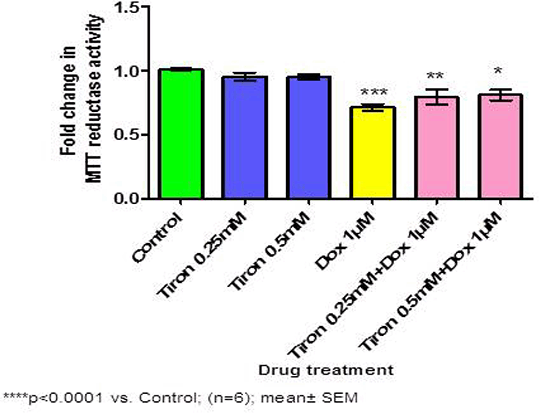| 133P London, UK Pharmacology 2016 |
Antioxidant Tiron protects against Doxorubicin-Induced Cardiotoxicity
Introduction: Doxorubicin is one of the most effective anti-cancer agents. However, its use is associated with adverse cardiac effects, including cardiomyopathy and progressive heart failure. Doxorubicin has been demonstrated to induce cardiac toxicity through the formation of free radicals1. The antioxidant Tiron has been shown to protect against reactive oxygen species (ROS) related injury in skin cells2.A recent investigation carried out by our group has indicated the ability of the antioxidant Tiron to offer cardio protection against Doxorubicin-induced toxicity in the Langendorff perfused rat heart model3. Given our recently reported beneficial effects of Tiron against doxorubicin induced myocardial injury3 we further investigated the effects of Tiron (0.25mM&0.5mM) on doxorubicin-induced (1µM) cardiac dysfunction in naïve and stressed conditions.
Methods: Drug-induced effects were assessed using isolated cardiomyocytes and cell viability levels measured following drug-treatment. Adult Sprague-Dawley rat ventricular cardiomyocytes were isolated using collagenase digestion and used to assess the cell viability following combined treatment of Doxorubicin (1µM) and Tiron (0.25mM & 0.5mM). Human cancerous cell lines (HepG2 and HL60) were used to evaluate the effects of combined treatment of Doxorubicin (1µM) and Tiron (0.25mM) on the cytotoxicity of doxorubicin in a cancer cell line. Cell viability in all cultured cells was assessed using MTT (3-(4,5-dimethylthiazol-2-yl)-2,5-diphenyltetrazolium bromide) assay and in vitro toxicology assay kit Resazurin based (TOX8). All data were presented as the mean±SEM, n=6. Data were analysed by one-way ANOVA and Tuckey’s post hoc test. Significance was considered P value ≤0.05.
Results: Doxorubicin (1µM) caused a significant impairment of cardiac function and decreased the myocyte viability in naïve conditions (1.01±0.007 vs. 0.711±0.06 n=6, p<0.0001). Interestingly, co-treatment of Doxorubicin (1µM) with Tiron (0.25mM & 0.5mM) attenuated the detrimental effects of Doxorubicin (0.79±0.16 vs. 0.711±0.06; 0.80±0.04 vs. 0.711±0.06, n=6, p<0.05) (Figure 1). Co-incubation of Tiron with Doxorubicin did not reduce the cytotoxicity of doxorubicin against HepG2 and HL60 cells (Table 1).

Figure 1: The MTT cytotoxicity analysis showing that Tiron reduces Doxorubicin cytotoxicity in adult ventricular cardiomyocytes

Table 1: The MTT cytotoxic analysis illustrating that Tiron does not inhibit the cytotoxicity of Doxorubicin in cancer cell lines (HepG2 and HL60); n=6; #p<0.05 vs. Control.
Conclusion: These data further supports the cardioprotective properties of the antioxidant Tiron against doxorubicin-induced cardiac injury. Data presented in this study highlights the potential of Tiron as protective adjunctive agent to ameliorate doxorubicin-induced cardiotoxicity without affecting its anticancer properties.
References
1. Davies and Doroshow (1986) J Biol Chem 261:3060-3067
2. Oyewole et al (2014) FASEB 28:485-494
3. Chiuzbaian et al (2015) pA2 online, BPS website

